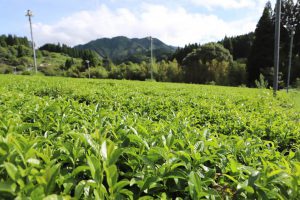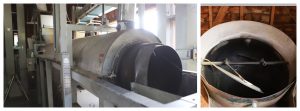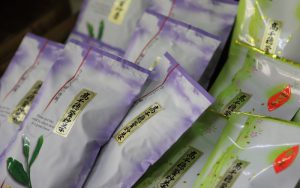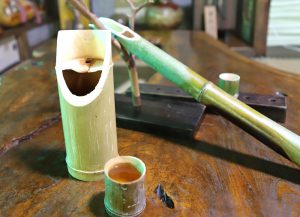MENU
MENU
Tea production areas: Miyakonojo City, Kawaminami Town, Shintomi Town, Kushima City, Miyazaki City, Takachiho Town, Gokase Town, Hinokage Town, etc.
Brand: Miyazaki tea, Miyakonojo tea, Kushima tea, Takachiho tea, Gokase tea, Hyuga tea
Types of tea: Kamairicha (pan-fired green tea), mushisei-tamaryokucha (steamed curly green tea), sencha (medium-steamed green tea), fukamushicha (deep-steamed green tea), matcha, kukicha (stem tea), hojicha (roasted green tea), genmaicha (green tea with roasted rice), black tea, bancha, powdered tea, etc.
Miyazaki tea
Miyazaki Prefecture is blessed with warm weather and fertile land. This environment is optimal for cultivating tea and tea is grown throughout the entire Prefecture.
Tea cultivated and produced in Miyazaki Prefecture is called Miyazaki tea collectively. However, there are tea brands for each region, such as Gokase tea.

Ogasaen’s Tea field in Gokase Town (August 2018)
Kamairicha (pan-fired green tea)
Tradition says that Kamairicha was introduced from the Korean Peninsula via Kumamoto in the 17th century. Kamairicha has long been made using wild tea in mountainous areas.
In the Edo Period, tea was cultivated and the tea was used as a tribute or tax.
Currently, the number of producers of kamairicha is decreasing. However, kamairicha is still produced in Nishiusuki Country, Miyazaki Prefecture.

Tea processing machine for kamairicha at Ogasaen (August 2018)
The kamairicha leaves are twisted into a rounded shape because the tea leaves are not formed by a machine like sencha. Kamairicha has a rich aroma and refreshing flavor.

Gokase kamairicha
Takachihogo-Shiibayama Mountainous Agriculture and Forestry System
Takachihogo and Shiibayama regions (Takachiho Town, Hinokage Town, Gokase Town, Morotsuka Village, and Shiiba Village) are steep mountainous areas surrounded by forests with little flat land. In the harsh environment of mountainous areas, people have coexisted with nature and valued community ties, and have made a living by combining forestry, agriculture, and livestock farming. The complex agricultural and forestry system, including the tea cultivation of kamairicha, in this area was recognized as a Globally Important Agricultural Heritage System (GHIAS) by the Food and Agriculture Organization of the United Nations (FAO) in 2015.
In addition, because this area is high in altitude and pests are less likely to thrive, many teas are cultivated without pesticides.

Takachiho kamairicha at Araraginochaya (August 2018)
Kappocha (Kappo tea)
In Takachiho, bamboo is called “Kappo” and was used as a container for dishes or drinks.
Kappocha is the name given to tea made using bamboo tubes. When people worked in a mountain, they drank kappocha during break time. The making method of kappocha is simple. Pluck leaves from tea plants found on the mountain and roast them on a bonfire lightly, and boil water in a long bamboo tube as a kettle and put the leaves in the bamboo tube. Then, pour the tea into a short bamboo tube used as a cup. When pouring the tea into a short bamboo tube from the long bamboo tube, it makes a sound like “kappo kappo”. Thus, it is also said that the tea came to be called kappocha.
There are kapposake and kappodori too. The kapposake is sake (Japanese rice wine) drunk from a bamboo tube and the kappodori is a dish of chicken and vegetables cooked in a bamboo tube.
The photo below was taken at a restaurant Araraginochaya in Takachihokyo-Gorge. Kappocha was not on the menu of Araraginochaya, but the staff of Araraginochaya prepared kappocha specially.

Kappocha at Araraginochaya in Takachihokyo Gorge (August 2018)
Tea-related facilities:
特産センター五ヶ瀬
あららぎ乃茶屋
小笠園 http://www.ogasaen.com
Tea mascot Yuru-Chara:
Ceramic and pottery art: Miyakonojo Ware
Reference:
松下智 (平成3年) 日本名茶紀行 (初版) 雄山閣出版
高野實・谷本陽蔵・富田勲・中川致之・岩浅潔・寺本益英・山田新市 (2005) 緑茶の事典 (改訂3版) 柴田書店
大森正司、阿南豊正、伊勢村護、加藤みゆき、滝口明子、中村羊一郎編(2017) 茶の事典 初版第一刷 朝倉書店
みやざき茶 http://www.m-tea.jp
世界農業遺産 高千穂郷・椎葉山地域
https://takachihogo-shiibayama-giahs.com
農林水産省 https://www.maff.go.jp
世界農業遺産・日本農業遺産 世界農業遺産・日本農業遺産認定地域 宮崎県高千穂郷椎葉山地域
https://www.maff.go.jp/j/nousin/kantai/giahs_3_080.html
*When visiting the shops and facilities introduced in this article, please check the business hours on their website, etc. before visiting.
*The information provided on this site may be updated. If you find any information in this article that is incorrect, new, or incomplete, please contact CHAMART.
*The site does not describe all “Teas of Japan” or all “Teas of the World”. Additionally, each article expresses the writer’s personal experience and feelings.
#miyazakitea #kamairicha #GIAHS #kappocha